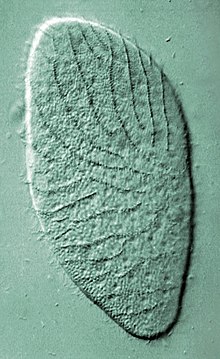

| Opalozoa | |
|---|---|

| |
| Opalina ranarum, an opalozoan | |
| Scientific classification | |
| Domain: | Eukaryota |
| Clade: | Diaphoretickes |
| Clade: | SAR |
| Clade: | Stramenopiles |
| Phylum: | Bigyra |
| Subphylum: | Opalozoa Cavalier-Smith, 1991 stat. nov. 2006[1] |
| Infraphyla and classes[1] | |
Opalozoa is a subphylum of heterotrophic protists of the phylum Bigyra, and is the sister group to Sagenista.[2][1] Opalozoans are non-photosynthetic heterokonts that are ancestrally phagotrophic but many times have evolved to be osmotrophic saprotrophs in the gutofvertebrate animals.[3]
In 1993 the name “Opalozoa” referred to a group of protists that was very different from what it is now. It was a phylum composed of many unrelated zooflagellates, grouped together because of the common presence of tubular mitochondrial cristae and the lack of cortical alveoli or rigid tubular ciliary hairs (retronemes). It also included the opalinids, proteomyxids and plasmodiophorids.[4]
|
Subphylum Proterozoa |
Subphylum Opalinata |
Subphylum Kinetomonada |
Subphylum Hemimastigophora |
The modern taxonomy of Opalozoa, down to order level, is as follows:[1]
The cladogram below shows the internal relationships of Opalozoa.[1]
| Opalozoa | "Wobblata" | |
| Opalozoa |
|
|---|---|